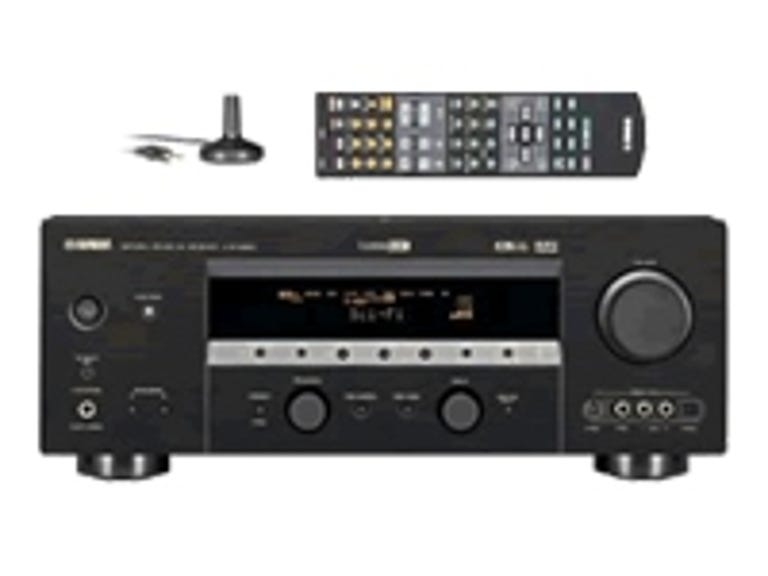 Why You Can Trust CNET
Why You Can Trust CNET Yamaha HTR-5860 review: Yamaha HTR-5860
Yamaha HTR-5860
While the company's list of A/V receivers is a daunting 20 strong, Yamaha's HTR-5860 stands out as offering great bang for the buck, listing for $550 but available for much less online. It's packed with useful features, and it sounds sweet. While the look is pretty generic and the feel too plastic for our tastes, its overall build quality is competitive with that of other brands' midprice models.
The Yamaha HTR-5860 measures a standard 17.1 inches wide and 16.5 deep, and it's available in black or silver. If you're intimidated by the hassles associated with installing an A/V receiver, the HTR-5860 will put you at ease. It features Yamaha's Parametric Room Acoustic Optimizer (YPAO) autosetup system. It's remarkably easy to use. Just place the included microphone in the listening position, bring up the setup menu, and press a few buttons--the HTR-5860 does the rest. Within a few minutes, the receiver will fine-tune the sound of your speakers for your room's acoustics.
The receiver delivers 110 watts to seven channels, but you can actually connect up to 11 speakers if you count the B set. Two of the extra channels can be used with Presence speakers placed outside and above the normal left- and right-front speakers. A/V inputs number five (including the front-panel set), two of which accept component-video sources. Audio connections include two more stereo inputs; a set of eight-channel/SACD/DVD-Audio inputs; eight-channel preamp outputs; four optical (three rear, one front) and two coaxial digital inputs; and one optical output. There's no HDMI input, which is to be expected in this price range--for now. The receiver will convert composite and S-Video sources such as VCRs to component video, which makes for easier connection duties to TVs. The HTR-5860 is also XM ready, which means it will act as an XM satellite receiver once you hook up a Connect-and-Play antenna (such as the $50 Audiovox CNP1000) and sign up for the $13-a-month service. The standard bevy of Dolby and DTS surround-processing modes is augmented by a selection of Yamaha's proprietary options.
The Yamaha HTR-5860 perfectly rendered the difficult-to-reproduce splashing water sounds in the Psycho-derivative shower scene on the What Lies Beneath DVD. The Cast Away DVD's plane crash scene yielded similarly impressive results; the roar of the jet engine, the pounding surf, and the wind were all terrifyingly real. Turning to music, the HTR-5860 punched out Metallica's St. Anger CD with impressive impact. The band's sledgehammer rhythm was crisp and clear, and Robert Trujillo's massive bass was rock solid.
If you like the HTR-5860 and don't already have a set of surround speakers, consider the Yamaha DTX-5100, which bundles the receiver with a Yamaha 5.1-speaker system and a CD/DVD changer for $1,100. If you're looking for alternatives to the HTR-5860, you can get the equally impressive Pioneer VSX-1015TX, which offers THX certification and an extra component input but sacrifices the built-in XM compatibility. But no matter how you slice it, the Yamaha HTR-5860 offers an impressive mixture of features and performance for its price.
The Yamaha HTR-5860 measures a standard 17.1 inches wide and 16.5 deep, and it's available in black or silver. If you're intimidated by the hassles associated with installing an A/V receiver, the HTR-5860 will put you at ease. It features Yamaha's Parametric Room Acoustic Optimizer (YPAO) autosetup system. It's remarkably easy to use. Just place the included microphone in the listening position, bring up the setup menu, and press a few buttons--the HTR-5860 does the rest. Within a few minutes, the receiver will fine-tune the sound of your speakers for your room's acoustics.
The receiver delivers 110 watts to seven channels, but you can actually connect up to 11 speakers if you count the B set. Two of the extra channels can be used with Presence speakers placed outside and above the normal left- and right-front speakers. A/V inputs number five (including the front-panel set), two of which accept component-video sources. Audio connections include two more stereo inputs; a set of eight-channel/SACD/DVD-Audio inputs; eight-channel preamp outputs; four optical (three rear, one front) and two coaxial digital inputs; and one optical output. There's no HDMI input, which is to be expected in this price range--for now. The receiver will convert composite and S-Video sources such as VCRs to component video, which makes for easier connection duties to TVs. The HTR-5860 is also XM ready, which means it will act as an XM satellite receiver once you hook up a Connect-and-Play antenna (such as the $50 Audiovox CNP1000) and sign up for the $13-a-month service. The standard bevy of Dolby and DTS surround-processing modes is augmented by a selection of Yamaha's proprietary options.
The Yamaha HTR-5860 perfectly rendered the difficult-to-reproduce splashing water sounds in the Psycho-derivative shower scene on the What Lies Beneath DVD. The Cast Away DVD's plane crash scene yielded similarly impressive results; the roar of the jet engine, the pounding surf, and the wind were all terrifyingly real. Turning to music, the HTR-5860 punched out Metallica's St. Anger CD with impressive impact. The band's sledgehammer rhythm was crisp and clear, and Robert Trujillo's massive bass was rock solid.
If you like the HTR-5860 and don't already have a set of surround speakers, consider the Yamaha DTX-5100, which bundles the receiver with a Yamaha 5.1-speaker system and a CD/DVD changer for $1,100. If you're looking for alternatives to the HTR-5860, you can get the equally impressive Pioneer VSX-1015TX, which offers THX certification and an extra component input but sacrifices the built-in XM compatibility. But no matter how you slice it, the Yamaha HTR-5860 offers an impressive mixture of features and performance for its price.
Score Breakdown
Design 7Features 8Performance 7


